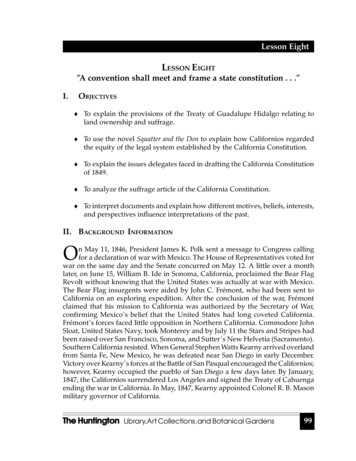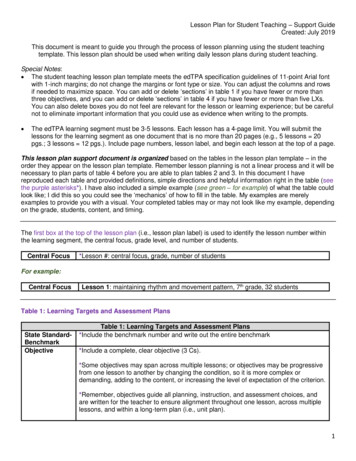
Transcription
Lesson EightLESSON EIGHT“A convention shall meet and frame a state constitution . . .”I.OBJECTIVES To explain the provisions of the Treaty of Guadalupe Hidalgo relating toland ownership and suffrage. To use the novel Squatter and the Don to explain how Californios regardedthe equity of the legal system established by the California Constitution. To explain the issues delegates faced in drafting the California Constitutionof 1849. To analyze the suffrage article of the California Constitution. To interpret documents and explain how different motives, beliefs, interests,and perspectives influence interpretations of the past.II. BACKGROUND INFORMATIONOn May 11, 1846, President James K. Polk sent a message to Congress callingfor a declaration of war with Mexico. The House of Representatives voted forwar on the same day and the Senate concurred on May 12. A little over a monthlater, on June 15, William B. Ide in Sonoma, California, proclaimed the Bear FlagRevolt without knowing that the United States was actually at war with Mexico.The Bear Flag insurgents were aided by John C. Frémont, who had been sent toCalifornia on an exploring expedition. After the conclusion of the war, Frémontclaimed that his mission to California was authorized by the Secretary of War,confirming Mexico’s belief that the United States had long coveted California.Frémont’s forces faced little opposition in Northern California. Commodore JohnSloat, United States Navy, took Monterey and by July 11 the Stars and Stripes hadbeen raised over San Francisco, Sonoma, and Sutter’s New Helvetia (Sacramento).Southern California resisted. When General Stephen Watts Kearny arrived overlandfrom Santa Fe, New Mexico, he was defeated near San Diego in early December.Victory over Kearny’s forces at the Battle of San Pasqual encouraged the Californios;however, Kearny occupied the pueblo of San Diego a few days later. By January,1847, the Californios surrendered Los Angeles and signed the Treaty of Cahuengaending the war in California. In May, 1847, Kearny appointed Colonel R. B. Masonmilitary governor of California.The Huntington Library,Art Collections, and Botanical Gardens99
Lesson EightOn February 2, 1848, the Treaty of GuadalupeHidalgo ended the war with Mexico and cededCalifornia to the United States. Before theratification of the treaty, Governor Masonexercised legitimate authority. Once peace wassecured, his authority was questioned. WhileCongress argued over sectional issues,especially the status of slavery in the Mexicancession, Governor Mason lost the support ofAnglo-Ameicans in the territory. The more themilitary tried to secure order, the more bitterAnglo-Americans became with the militarygovernment. Californios, on the other hand,were supportive of the military regime largelybecause it recognized their rights as specifiedin the peace treaty.By summer 1848, as word of the discovery of goldspread, residents from all parts of the stateabandoned their towns and villages and flockedto the gold fields. The flight wrecked agriculturalproduction and commerce in the territory.Officers and soldiers abandoned their regiments, sailors deserted their ships, and localgovernment leaders (alcaldes) relinquished their responsibilities to search for gold. Facedwith an impossible task of governing and with no immediate hope of Congressionalaction on establishing civilian government, Mason resigned in November 1848.Anglo-Americans formed Committees of Correspondence to call for a conventionto establish a civilian government. Mason’s replacement, Brevet General BennettC. Riley, arrived in April 1849. Recognizing that the Congress was deadlockedover the issue of slavery in California, the increasing lawlessness in the gold fields,and that the military was incapable or unwilling to control the situation, Rileycalled for an election of representatives to a convention to frame a constitution tosubmit to Congress. Forty-eight delegates met in Monterey to draw up a constitution.Six of the forty-eight had been born in California, while thirty-four delegates hadlived in California for six years or less. Four were born in Europe, all of whom hadlived in California for ten years or longer (John Sutter, a native of Switzerland, wasone of these four). The two remaining delegates were Thomas Larkin and AbelStearns, both born in Massachusetts. Larkin had resided in Monterey for sixteenyears prior to the constitutional convention and had served as U.S. Consul in theMexican capital of Alta California. Stearns had lived in Mexico before establishinga residence in Los Angeles about 1829.100The Huntington Library,Art Collections, and Botanical Gardens
Lesson EightIII MATERIALS« Document 1—Provisions of the Treaty of Guadalupe Hidalgo« Document 2—Governor Mason’s Proclamation to the People of UpperCalifornia, August 7, 1848« Document 3—The Squatter and the Don by María Amparo Ruiz de Burton« Document 4—Governor Riley’s Proclamation To the People of California, June3, 1849« Document 5—Constitutional Convention from the Land of Golden Dreams:California in the Gold Rush Decade, 1848–1858« Document 6—Draft of Article 2 submitted to the Constitutional Conventionof 1849« Document 7—Article 2 of the Constitution of 1849IV. LESSON ACTIVITIESA. Read text accounts of the Nicholas Trist mission to negotiate a settlement toend the war with Mexico. Review with students the provisions of the Treatyof Guadalupe Hidalgo (Document 1). Have students assume the roles ofMexican citizens residing in Upper California, including Spaniards, Mestizos, Indians, and free Blacks (slavery had been abolished in Mexico in1829). From their respective roles, students record in a journal their views ofhow life will change as a result of the annexation of California by the UnitedStates. As a class, discuss:1. who will have the right to be a citizen of the United States.2. how the annexation will affect land holdings.3. the extent to which life will improve, worsen, or remain the same.B. Select a student to read to the class Governor Mason’s Proclamation to the Peopleof Upper California (Document 2). As a class, discuss the prospects for theestablishment of civil government in California. According to Governor Mason,what are the benefits that will come from the peace treaty? Under the treaty,what rights do Californios have? What is the “new destiny” of California?C. Read an excerpt from María Amparo Ruiz de Burton’s novel The Squatter andthe Don on the Treaty of Guadalupe Hidalgo (Document 3). What was DonMariano’s attitude toward the treaty? According to Don Mariano, did thegovernment of California comply with the provisions of the treaty? If youassumed the character of George in this brief excerpt from the novel, howwould you have responded to Don Mariano? What is the point the author ismaking about the land claims of Californios?The Huntington Library,Art Collections, and Botanical Gardens101
Lesson EightD. Have the class read Governor Riley’s Proclamation to the People of California(Document 4). Inform the class that Californios, especially those in thesouth, were supportive of military rule. Anglo-Americans who had settled inCalifornia before the Gold Rush and settlers who flocked to the territory insearch of gold wanted an immediate end to military rule and theestablishment of civil authority. Have students, in pairs, discuss theproclamation from both perspectives.E. Read to the class an excerpt from the Land of Golden Dreams exhibitioncatalogue (Document 5) as background information before examining thesuffrage article adopted by the convention.F. Examine the draft of Article II of the Constitution approved by theconvention (Document 6) and compare it to Article II of the ratifiedconstitution (Document 7). Explain how the articles differ. Review Article IXof the Treaty of Guadalupe Hidalgo and explain how Section 1 of Article IIis more in line with the provisions of the treaty than the draft document. Howdoes Section 4 of Article II differ from the committee’s draft?G. Conclude the lesson with a creative writing assignment. Have studentsassume the roles of reporters and write an article or feature story on thesuffrage article from the perspective of a Californio or entscovetemulateex calretroactivesuffragevacillateVI. EXTENDED LESSON IDEASA Research the land issue. Conduct a moot court hearing in which a Californioattempts to confirm his title to land under a grant from the Mexicangovernment dating from the 1820s or 1830s.B. Using the public library or local historical society archives, research theranchos in your community. What information can you find regarding landtitles? How difficult was it for the Californio to have the state recognize his102The Huntington Library,Art Collections, and Botanical Gardens
Lesson Eighttitle to the land?C. Examine the suffrage section of the California Constitution of 1879. Howdoes it differ from the Constitution of 1849? What are the suffragequalifications of the current state constitution?D. As a creative writing assignment, have students write a short chapter for anovel, patterned after that of María Amparo Ruiz de Burton’s The Squatterand the Don, from the perspective of an Anglo-American. How accurate wasyour depiction of events? How did it differ from Ruiz de Burton’s account?Discuss how literature can be used as a means of promoting a point of view.The Huntington Library,Art Collections, and Botanical Gardens103
Document 1Lesson EightTreaty of Guadalupe HidalgoOn February 2, 1848, Mexican and American commissionersinitialed the Treaty of Guadalupe Hidalgo, bringing theMexican-American War to a conclusion. The United StatesSenate ratified the treaty on March 10.PreambleIn the name of Almighty God: The United States of America, and the UnitedMexican States, animated by a sincere desire to put an end to the calamitiesof the war which unhappily exists between the two Republics, and toestablish upon a solid basis relations of peace and friendship, which shallconfer reciprocal benefits upon the citizens of both, and assure the concord,harmony and mutual confidence, wherein the two peoples should live, asgood neighbors, have for that purpose . . . arranged, agreed upon, and signedthe following Treaty of Peace, Friendship, Limits and Settlement between theUnited States of America and the Mexican Republic. . . .****Article VThe Boundary line between the two Republics shall commence in the Gulf ofMexico, three leagues from land, opposite the mouth of the Rio Grande . . . fromthence, up the middle of that river . . . to the point where it strikes the southernboundary of New Mexico; thence, westwardly, along the whole southernboundary of New Mexico . . . to its western termination; thence, northward,along the western line of New Mexico, until it intersects the first branch of theriver Gila; . . . and thence down the middle of the . . . river, until it empties intothe Rio Colorado; thence, across the Rio Colorado, following the division linebetween Upper and Lower California, to the Pacific Ocean. . . .****Article VIIIMexicans now established in territories previously belonging to Mexico, andwhich remain for the future within the limits of the United States, as definedby the present treaty, shall be free to continue where they now reside, or to104The Huntington Library,Art Collections, and Botanical Gardens
Document 1Lesson Eightremove at any time to the Mexican Republic, retaining the property whichthey possess in the said territories, or disposing therefore, and removing theproceeds wherever they please. . . .Those who shall prefer to remain in the said territories, may either retain thetitle and rights of Mexican citizens, or acquire those of citizens of the UnitedStates. But they shall be under the obligation to make their elections withinone year from the date of the exchange of ratifications of this treaty: and thosewho shall remain in the said territories, after the expiration of that year,without having declared their intention to retain the character of Mexicans,shall be considered to have elected to become citizens of the Untied States.In the said territories, property of every kind, now belonging to Mexicans,not established there, shall be inviolably respected. The present owners, theheirs of these, and all Mexicans who may hereafter acquire said property bycontract, shall enjoy with respect to it, guaranties equally ample as if thesame belonged to citizens of the United States.***Article IXThe Mexicans who, in the territories aforesaid, shall not preserve thecharacter of citizens of the Mexican Republic, conformably with what isstipulated in the preceding article, shall be incorporated into the Union of theUnited States and admitted, at the proper time (to be judged of by theCongress of the United States) to the enjoyment of all the rights of citizens ofthe United States according to the principles of the Constitution; and in themean time shall be maintained and protected in the free enjoyment of theirliberty and property, and secured in the free exercise of their religion withoutrestriction.The Huntington Library,Art Collections, and Botanical Gardens105
Document 2Lesson Eight“Proclamation to the People of Upper California”August 7, 1848106The Huntington Library,Art Collections, and Botanical Gardens
Document 2Lesson Eight“Proclamation to the People of Upper California”[transcription] August 7, 1848The undersigned has the pleasure to announce the ratification of a Treaty of peaceand friendship between the United States of America and the Mexican Republic, bywhich Upper California is ceded to the United States.The boundary separating this country from Lower California, “consists of a straightline drawn from the middle of the Rio Gila, where it unites with the Colorado, to apoint on the coast of the Pacific Ocean distant one marine league due south of thesouthernmost point of the port of San Diego.”. . . The undersigned has received instructions from Washington, to take propermeasures for the permanent occupation of the newly acquired Territory. TheCongress of the United States (to whom this power alone belongs), will soon conferupon the people of this country, the constitutional rights of citizens of the UntiedStates; and no doubt, in a few short months, we shall have a regularly organisedterritorial government. . . .From this new order of things, there will result to California a new destiny. Insteadof revolutions and insurrections, there will be internal tranquility; instead of a fickleand vacillating policy, there will be a firm and stable government, administeringjustice with impartiality, and punishing crimes with the strong arm of power. Thearts and sciences will flourish; and the labors of the agriculturist, guided by thelamp of learning, will stimulate the earth to the most bountiful production.Commerce, freed from the absurd restrictions formerly imposed, will be greatlyextended; the choked up channels of trade will be opened, and the poisonedfountains of domestic faction forever dried up. Americans and Californians willnow be one and the same people, subject to the same laws, and enjoy the same rightsand privileges. They should therefore become a band of brothers, emulating eachother in their exertion to develope the wealth and resources, and to secure the peace,happiness, and permanent prosperity of their Common Country.Done at Monterey, California, this seventh day of August, 1848,R. B. MASON,Col. 1st Drags. andGov. of California.The Huntington Library,Art Collections, and Botanical Gardens107
Document 3Lesson EightThe Squatter and the DonMaría Amparo Ruiz de Burton, descendant of a wellestablished Baja California land-owning family, marriedColonel Henry Burton, an officer in the U.S. army during thewar with Mexico. Ruiz de Burton was sharply critical of thefailure of the state to readily recognize Spanish and Mexicanland grants. In her 1885 novel she offered a harsh indictment ofthe impoverishment and dispossession of many Californiosbecause of the state’s land policy established by the landCommission Act of 1851. . . “I remember,” calmly said Don Mariano, “that when I first read the textof the treaty of Guadalupe Hidalgo, I felt a bitter resentment against mypeople; against Mexico, the mother country, who abandoned us—herchildren—with so slight a provision of obligatory stipulations forprotection. But after wards, upon mature reflection, I saw that Mexico did asmuch as could have been reasonably expected at the time. In the verypreamble of the treaty the spirit of peace and friendship, which animatedboth nations, was carefully made manifest. That spirit was to be thefoundation of the relations between the conqueror and conquered. How couldMexico have foreseen than that when scarcely half a dozen years should haveelapsed the trusted conquerors would, ‘In Congress Assembled,’ pass lawswhich were to be retroactive upon the defenseless, helpless, conqueredpeople, in order to despoil them? The treaty said that our rights would be thesame as those enjoyed by all other American citizens. But, you see, Congresstakes very good care not to enact retroactive laws for Americans; laws to takeaway from American citizens the property which they hold now, already,with a recognized legal title. No, indeed. But they do so quickly enough withus—with us, the Spano-Americans, who were to enjoy equal rights, mindyou, according to the treaty of peace. This is what seems to me a breach offaith, which Mexico could neither presuppose nor prevent.”“It is nothing else, I am sorry and ashamed to say,” George said. “I neverknew much about the treaty with Mexico, but I never imagined we had actedso badly.”“I think but few Americans know or believe to what extent we have beenwronged by Congressional action. And truly, I believe that Congress itselfdid not anticipate the effect of the laws they impose upon people,” said DonMariano, sadly.108The Huntington Library,Art Collections, and Botanical Gardens
Lesson EightDocument 3“It is the duty of law-givers to foresee the effect of the laws they impose uponpeople,” said Doña Josefa.“That I don’t deny, but I fear that the conquered have always but a weakvoice, which nobody hears,” said Don Mariano. “We have had no one tospeak for us. By the treaty of Guadalupe Hidalgo the American nationpledged its honor to respect our land titles just the same as Mexico wouldhave done. Unfortunately, however, the discovery of gold brought toCalifornia the riff-raff of the world, and with it a horde of land-sharks, allpossessing the privilege of voting, and most of them coveting our lands, forwhich they very quickly began to clamor. There was, and still is, plenty ofgood government land, which any one can take. But no. The forbidden fruitis the sweetest. They do not want government land. They want the land of theSpanish people, because we ‘have too much,’ they say. . . .”The Huntington Library,Art Collections, and Botanical Gardens109
Document 4Lesson EightProclamation to the People of CaliforniaGeneral Bennett Riley was appointed “civil governor” ofCalifornia in an attempt to play down the military control ofthe territory. Regardless of his title, it was impossible todisguise the fact that Riley was an army officer acting underdirect orders of the War Department. The U.S. Congress,bogged down in sectional disputes, adjourned in 1849 withouttaking up the issue of California. Governor Riley’sProclamation of June 3 calling for a constitutional conventionwas a means of undercutting the growing resentment ofmilitary rule and the independent efforts, especially amongnew emigrants, to create local provisional governments indifferent regions of the territory.Congress having failed at its recent session to provide a new government for thiscountry to replace that which existed on the annexation of California to the UnitedStates, the undersigned would call attention to the means which he deems bestcalculated to avoid the embarrassments of our present condition.The undersigned, in accordance with instructions from the Secretary of War, hasassumed the administration of civil affairs in California, not as a military Governor,but as the executive of the existing civil government. In the absence of a properlyappointed civil Governor, the commanding officer of the Department, is, by thelaws of California, ex officio civil Governor of the country, and the instructions fromWashington were based on the provisions of these laws. . . .The laws of California, not inconsistent with the laws, constitution and treaties of theUnited States, are still in force and must continue in force till changed by competentauthority. Whatever may be thought of the right of the people to temporarily replacethe officers of the existing government by others appointed by a provisionalTerritorial Legislature, there can be no question that the existing laws of the countrymust continue in force till replaced by others made and enacted by competent power.That power by the treaty of peace, as well as from the nature of the case, is vested inCongress. . . .The situation of California is almost identical with that of Louisiana, andthe decisions of the Supreme Court in recognising the validity of the laws whichexisted in that country previous to its annexation to the United States, where notinconsistent with the constitution and laws of the United States . . . furnish us a clearand safe guide in our present situation. . . .As Congress has failed to organize a new Territorial Government it becomes ourimperative duty to take some active measures to provide for the existing wants of110The Huntington Library,Art Collections, and Botanical Gardens
Lesson EightDocument 4the country. This, it is thought, may be best accomplished by putting in full vigorthe administration of the laws as they now exist, and completing the organizationof the civil government by the election and appointment of all officers recognized bylaw: While at the same time a convention, in which all parts of the Territory arerepresented, shall meet and frame a State constitution or a Territorial organization,to be submitted to the people for their ratification and then proposed to Congress forits approval. Considerable time will necessarily elapse before any new governmentcan be legitimately organised and put in operation; in the interim the existinggovernment, if its organization be completed, will be found sufficient for all ourtemporary wants. . . .Every free male citizen of the United States and of Upper California 21 years of age,and actually resident in the district where the vote is offered, will be entitled to theright of suffrage. All citizens of Lower California who have been forced to come tothis territory on account of having rendered assistance to theAmerican troops during the recent war withMexico, should also beallowed to vote in thedistrict where they actually reside. . . .Given at Monterey,California, this thirdday of June, A.D. 1849.(signed) B. RILEYBrevet Brig. Genl.U.S.A., and Governorof California.Official—H. W.HALLECK,Bvt. Capt. andSecretary of State.The Huntington Library,Art Collections, and Botanical Gardens111
Document 5Lesson EightThe Constitutional Convention(Secondary Source)Forty-eight delegates were elected to attend the ConstitutionalConvention, which met in Monterey between September 3 andOctober 13, 1849. Most of the delegates were from northernregions of the territory that were settled by Anglo-Americans.Miners were the largest single segment of the population inthis region, but they were too busy searching for gold to senddelegates to the convention.The forty-eight men chosen to devise a written charter for the state-to-bearrived in Monterey to begin their work on September 3, 1849. Californios,Anglo-American “old settlers,” veterans . . . who had settled in Californiaafter their release from the service, and argonauts from various parts of theUnited States, they possessed a formidable array of backgrounds,occupations and interests. Included among them were men who had stoodon opposite sides of the Mexican-American War, men whose ties toCalifornia reached back decades, and men who had only just arrived fromthe United States. Drawn heavily from the ranks of merchants, lawyers,farmers and ranchers, the membership of the convention representedsegments of the population who all desired the establishment of stable,orderly government, although the degree and scope of its power could bedebated. . . . . . [F]or the Californios, the convention’s efforts constituted a fundamentalredrawing of their political landscape according to the vision of others.Nonetheless, they did manage to secure certain measures to protect mattersof importance to their constituents, such as ensuring that the newgovernment’s public documents would have to be published in Spanish aswell as English. Though not a solidly unified voting bloc, they and theirAnglo-American allies such as Abel Stearns and Stephen Foster representeda quarter of the convention’s strength. . . .Reshaping the political world of California, however, did pullAnglo-Americans and Californios into fractious debate on more than oneoccasion during the convention. When the convention began to lay out thestandards for who could exercise the right to vote, for example, it followedthe standard American practice of the time and limited suffrage to whitemale citizens over the age of twenty-one. Some members of the conventionpointed out, however, that under the stipulations of the Treaty of Guadalupe112The Huntington Library,Art Collections, and Botanical Gardens
Lesson EightDocument 5Hidalgo, citizens of the Mexican Republic who accepted Americancitizenship had to be accorded the full rights and privileges of any othercitizen. Moreover, while the notion of granting the right to vote generally tomembers of what one delegate described as those “objectionable races,”African-Americans and Indians, received no strong support, other delegatesnoted that to limit the franchise only to white males might well act to barsome of the Californios of mixed ancestry and dark complexion. As acompromise, the final version of the suffrage article included a provisionthat the legislature could, at a later date, choose to grant Indians the right tovote, though such a measure would need the support of two-thirds of thelegislature. Furthermore, it specifically recognized the right of citizens ofMexico to vote after they had become citizens of the United States—as longas they were white. . . .Peter Blodgett, Land of Golden Dreams: California in the Gold Rush Decade, 1848–1858 (San Marino: Huntington Library Press, 1999), used by permission.The Huntington Library,Art Collections, and Botanical Gardens113
Lesson EightDocument 6Draft of Article II of the California Constitution of 1849The Committee appointed to report to the Convention “a plan or any portion of aplan for a state constitution,” having had the same under consideration respectfullyreport further as follows—Sec. 1st Every white male citizen of the United States, of the age of twenty one years,who shall have been a resident of the State six months next preceeding the election,and the County (District) in which he claims his vote thirty days, shall be entitledto vote at all elections which are or hereafter may be authorized by law.Sec. 2d Electors shall in all cases except treason, felony or breach of the peace, beprivileged from arrest on the days of election, during their attendance at suchelection, going to and returning therefrom.Sec. 3d No elector shall be obliged to perform militia duty on the day of election,except in time of war or public danger.Sec. 4th No person in the military, naval,or marine service of the United States, shallbe considered, a resident of this State bybeing stationed in any garrison, barrack,or military or naval place, or station withinthe State.Sec. 5th No idiot or insane person orperson convicted of any infamous crime,shall be entitled to the privileges of anelector.Sec. 6th All elections by the people shall beby ballot.All of which is respectfully submitted(Signed)Myron NortonChairman114The Huntington Library,Art Collections, and Botanical Gardens
Document 7Lesson EightArticle II of the California ConstitutionA designated committee on suffrage adopted Article II of theConstitution and submitted them to the Convention for finalapproval.Sec. 1. Every white male citizen of the United States, and every white malecitizen of Mexico, who shall have elected to become a citizen of the UnitedStates, under the treaty of peace exchanged and ratified at Querétaro, on the30th day of May, 1848, of the age of twenty-one years, who shall have beena resident of the State six months next preceding the election, and the countyor district in which he claims his vote thirty days, shall be entitled to vote atall elections which are now or hereafter may be authorized by law: Provided,that nothing herein contained, shall be construed to prevent the Legislature,by a two-thirds concurrent vote, from admitting to the right of suffrage,Indians or the descendants of Indians, in such special cases as such aproportion of the legislative body may deem just and proper.Sec. 2. Electors shall, in all cases except treason, felony, or breach of thepeace, be privileged from arrest on the days of the election, during theirattendance at such selection, going to and returning therefrom.Sec. 3. No elector shall be obliged to perform militia duty on the day ofelection, except in time of war or public danger.Sec. 4. For the purpose of voting, no person shall be deemed to have gainedor lost a residence by reason of his presence or absence while employed in theservice of the United States; nor while engaged in the navigation of thewaters of this State, or the United States, or of the high seas;
The Huntington Library ,Art Collections and Botanical Gardens, 101 Lesson Eight III MATERIALS Document 1—Provisions of the Treaty of Guadalupe Hidalgo Document 2—Governor Mason's Proclamation to the People of Upper California, August 7, 1848 Document 3—The Squatter and the Don by María Amparo Ruiz de Burton Document 4—Governor Riley's Proclamation To the People of California, June










